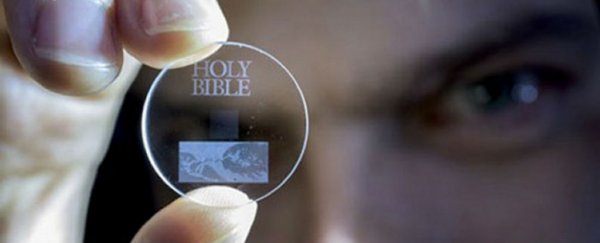It's estimated that humans are producing the equivalent of 10 million Blu-ray discs' worth of data every single day - and all of those ones and zeroes have to be stored somewhere. Now researchers in the UK just might have the solution: a five-dimensional (5D) digital data disc that can store 360 terabytes of data for some 13.8 billion years.
To create the data disc, researchers from the University of Southampton used a process called femtosecond laser writing, which creates small discs of glass using an ultrafast laser that generates short and intense pulses of light. These pulses can write data in three layers of nanostructured dots separated by 5 micrometres (that's 0.005 mm).
So where do the five dimensions come from? First there's the three-dimensional position of each dot within the layers, and then the extra dimensions are the size and orientation of the dot. The nanostructures created by the technology can be read using an optical microscope in tandem with a polariser (a filter designed to block specific polarisations of light).
The team behind the new 5D discs says these discs could be most useful for institutions who deal with large archives: libraries, museums, and anywhere else extensive records are kept (like a Facebook data centre).
"It is thrilling to think that we have created the technology to preserve documents and information and store it in space for future generations," said one of the researchers, Peter Kazansky. "This technology can secure the last evidence of our civilisation: all we've learnt will not be forgotten."
The researchers are presenting their work at the the International Society for Optical Engineering Conference in San Francisco this week, and after that, they're hoping to find industry specialists to partner with in order to develop the technology further, finally getting it to a stage where it could be used in commercial products.
The storage medium has been dubbed the 'Superman memory crystal' in honour of the memory crystals from the Superman films. Not only can it store crazy amounts of data, but it can withstand temperatures up to 1,000°C (1,832°F).
While the technology was first demonstrated in 2013, it's now capable of storing much more data: the team has already saved copies of the Universal Declaration of Human Rights (UDHR), Newton's Opticks, The Magna Carta and The King James Bible on these tiny discs.
